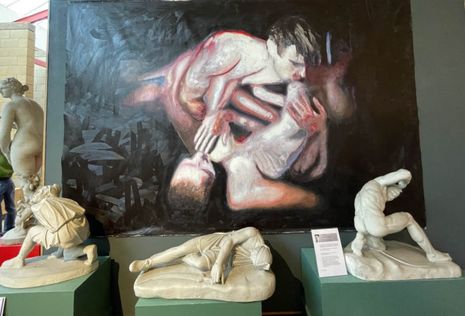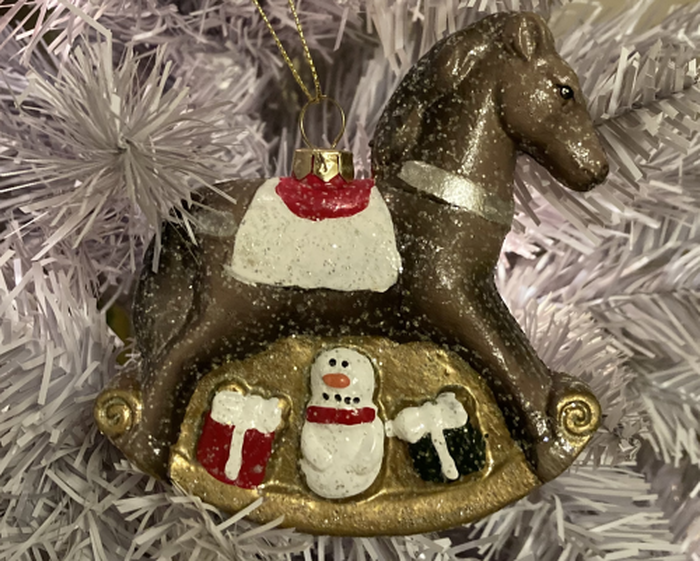‘Bodies Past and Present’: in conversation with Miriam Mitchell and Connor Phillips
In the Museum of Classical Archaeology, Laura Potomova discovers the new student art that lies between the plaster casts

“Not many people know about it”, says Connor as we walk into the low, brick block that is the Classics Faculty, his words a reassuring response to my tentative confession that in my three years here, I’d never set foot in the Museum of Classical Archeaology (MOCA). Located above the Classics library at the top of a rather dark, shadowy staircase, the Museum itself is light and spacious, and harbours one of the largest plaster cast collections in the world.
Until the 12th of January, the MOCA is also home to its first ever student exhibition, ‘Bodies Past and Present’, which features the work of eleven students from the Architecture, Classics and English faculties. Dispersed between the casts, ranging across a variety of media from oil to plaster, patchwork and embroidery, clay and cement, the works speak to each artist’s talent, dedication and individuality in their diverse portrayals of the human body, their unique responses to the question of what it means to be human.
Classicist Miriam Mitchell and architect Connor Phillips, the minds behind ‘Bodies Past and Present’ and co-curators of the exhibition, lead me confidently through the gallery. Their familiarity with the space helps diffuse my own initial uncertainty, and as we weave around the permanent cast display to look more closely at the student pieces, I find myself succumbing to the gallery’s rhythm, its dynamic, relaxed atmosphere. Soon I am racing against the artwork, playing a game of hide-and-seek: try to find it before it finds you. Where bursts of colour stray from the paleness of the casts, I succeed easily. I am immediately drawn, for instance, to Samia Rashid’s ‘Deus et Machina’, its vivid bronzy-gold shimmer couching the coldness of the busts beneath in a warm, comforting glow. The vibrant greens that spring from the stone slabs of St John’s cloisters in Shawn Mwenje’s ‘Untitled (Alone)’ also stand out, rising out above a row of pale, fragmented Greco-Roman statues— the originals of these, Mim tells me, would not have been so colourless themselves had it not been for years of white-washing, the destructive result of Western aesthetics’ tendency to elevate whiteness over colour.
“Soon I am racing against the artwork, playing a game of hide-and-seek: try to find it before it finds you”
In my game of hide-and-seek, other pieces catch me by surprise. Most notably, Edward Xu’s ‘Meridian’ which jumps out at me suddenly from its camouflaged position in the wall, hauntingly archaic and heavy in its stiffness. The clay busts created by Hanna Alma Turi also have a startling effect: hidden in the midst of a sea of frowning faces, they materialize only to the attentive observers, rewarding them with their surprising range of impressive, wirey hairstyles.
But it is only after my encounter with Bertie Politi’s ‘Body of Water’, a piece of arresting patchwork that drifts gently down the arm of the stone Doryphoros on which it is draped, that I realize the extent of the informality, the playfulness with which the exhibition is assembled. In the Cast Gallery, there is little of that sense of detached voyeurism, of hierarchies of knowledge and power that sometimes characterize larger museums, where artwork suffocates behind insistent, impenetrable screens of glass. Smiling at the gallery’s playful captions — “our statues thank you for not touching them. We know it’s tempting, but they’re very fragile” — I feel like a welcome visitor entering a dynamic, intimate space, entrusted to listen and engage in the conversations created within it. This becomes immediately clear in the first of the exhibition’s pieces, an oil painting by third-year architect Ata Gonul, which despite its subject matter and title, ‘Authority and Obedience’, greets the guest at eye level to establish a domestic, democratic atmosphere.
“I feel like a welcome visitor entering a dynamic, intimate space”
But it is the strands of conversation established within the exhibition, and between the works and the surrounding casts, that give the museum its distinctly dynamic, interactive feel. I catch glimpses of these conversations as we walk through: I watch as the bust of Menelaos catches the eye of Samia’s young male figure, as the men in Connor’s ‘An Expression’ reach out in the tangled mess of their muscles and limbs to the sculpture of ‘The Wrestlers’ in the same bay. I trace recurring themes like pieces of thread weaving invisible networks between the works, like the fragile perceptions of drapery, light and darkness that unite Ruby Schofield’s ‘Chorus’ with Alice Basus’s painted diptych. Or the cast-like repetition of Isabel May Painter’s vulnerable ‘Hold On’, a large-scale version of a childish paper cut-out which mirrors the frieze that frames it from above, even as it departs in its fourth, ‘matured’ body from the frieze’s paleness.
We stop at Mim’s reinterpretation of the lekythos, an ancient Greek vase used to store oil for funerary rituals. Painted in faded purples and reds, it seems to unite in its depiction of a series of classical images the exhibition’s recurring themes of violence and pleasure, queerness, nudity and voyeurism. “I dropped it three times so it’s cracked in places,” she laughs, the vase towering over her in its large-scale grandness. But these cracks only add to the unique, artisanal quality of the art, drawing attention to the process, the time and the dedication that had been poured into the exhibition as a whole, making the visitor’s experience all the more domestic and intimate.
So next time you’re on Sidge, go pay ‘Bodies Past and Present’ a visit. Play a quick game of hide-and-seek: who knows, you might even spot all eleven pieces.
‘Bodies: Past and Present’ is free to visit at The Museum of Classical Archaeology until 12th January 2024.
 Comment / Cambridge is right to scrap its state school target1 May 2024
Comment / Cambridge is right to scrap its state school target1 May 2024 News / Academics call for Cambridge to drop investigation into ‘race realist’ fellow2 May 2024
News / Academics call for Cambridge to drop investigation into ‘race realist’ fellow2 May 2024 News / Gender attainment gap to be excluded from Cambridge access report3 May 2024
News / Gender attainment gap to be excluded from Cambridge access report3 May 2024 News / Cambridge postgrad re-elected as City councillor4 May 2024
News / Cambridge postgrad re-elected as City councillor4 May 2024 Comment / Accepting black people into Cambridge is not an act of discrimination3 May 2024
Comment / Accepting black people into Cambridge is not an act of discrimination3 May 2024





